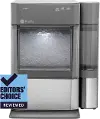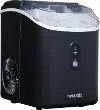#myrcwilleyhome
See how real customers are transforming their spaces with RC Willey. Get inspired, share your style, and create a space that's Your Home. Your Way.
Explore NowUnderstanding Ice Makers
An ice maker can be a game-changer for your kitchen, outdoor bar, or even your office. From keeping drinks perfectly chilled to ensuring you always have ice on hand for gatherings, these machines are designed with convenience and efficiency in mind.
Definition and Purpose
An ice maker is an appliance specifically designed to produce ice in various shapes and sizes. Unlike the traditional method of using ice cube trays in your freezer, ice makers provide a faster and more consistent supply of ice.
Key Purposes of Ice Makers:
- Convenient and quick ice production.
- Eliminates the hassle of manually filling ice trays.
- Ideal for hosting parties, outdoor events, or businesses requiring consistent ice supply.
Whether you need crushed ice for cocktails or standard cubes for everyday use, ice makers simplify the process.
Differences Between Ice Makers and Ice Machines
While the terms "ice maker" and "ice machine" are often used interchangeably, they refer to different appliances:
- Ice Makers: Typically smaller and designed for residential or light commercial use. These can be built into refrigerators, installed under countertops, or used as portable countertop models.
- Ice Machines: Larger, standalone units built for heavy-duty commercial use, such as in restaurants or hotels. These machines often produce higher volumes of ice and require more space and installation.
At RC Willey, you’ll find a variety of ice makers that fit seamlessly into your lifestyle.
Types of Ice Makers
Ice makers come in various styles to suit different needs and spaces. Here's an overview of the most popular types:
- Countertop Ice Makers:
Portable and compact, these are ideal for smaller kitchens, offices, or RVs. They’re easy to move and often produce ice in as little as 10 minutes.
- Perfect for occasional use or small gatherings.
- Designed to fit seamlessly under your kitchen counter or bar area.
- These are more permanent installations and can produce higher volumes of ice.
- Great for households or businesses that frequently need ice.
- Larger units designed for those who need a significant amount of ice daily.
- These are commonly found in commercial settings or outdoor kitchens.
- Offer flexibility in placement since they don’t require cabinetry installation.
At RC Willey, we offer a range of ice makers to match your style, space, and ice production needs.
Choosing the Right Ice Maker
Selecting the ideal ice maker involves more than just choosing a style. Whether you need an ice maker for your home, business, or special use, it’s essential to consider factors like size, capacity, and energy efficiency to meet your specific needs.
Considerations for Home Use
When choosing an ice maker for home use, focus on convenience, size, and functionality:
- Space: Determine where you’ll place your ice maker. Countertop models are great for smaller kitchens, while undercounter or freestanding units work well in larger spaces.
- Ice Type: Think about the type of ice you prefer—clear cubes for drinks, nugget ice for chewing, or crushed ice for cocktails.
- Production Capacity: If you host frequent gatherings or have a large household, choose a model with a higher daily ice production rate.
- Portability: Countertop models are easy to move and set up, making them ideal for flexible use in multiple areas.
Ice Type and Ice Production Capacity
Different types of ice suit different needs. Choose based on your preferences and how much ice you need daily:
- Types of Ice:
- Clear Cubes: Perfect for cocktails and high-end beverages.
- Nugget Ice: Chewy and soft, great for sodas and blended drinks.
- Crushed Ice: Ideal for cocktails, smoothies, and keeping seafood cold.
- Production Capacity: Check the machine’s daily ice output to ensure it matches your needs. For home use, 20–30 lbs/day is often sufficient, while businesses may need 70–100 lbs/day or more.
Energy Efficiency and Usage
Energy-efficient ice makers save money on utility bills and are better for the environment:
- Energy Star Certification: Look for models with this certification for lower energy consumption.
- Water Usage: Some ice makers are designed to minimize water waste, making them more eco-friendly.
- Automatic Features: Features like automatic shutoff when the bin is full can help save energy and reduce wear and tear.
At RC Willey, we offer ice makers designed to suit a variety of needs, from energy-efficient models to high-capacity machines for commercial use.
Practical Tips for Ice Maker Use
Maximizing the efficiency and lifespan of your ice maker involves proper installation, regular maintenance, and timely troubleshooting. With these practical tips, you’ll enjoy reliable ice production for years to come.
Installation and Maintenance
Proper installation and routine maintenance are key to ensuring your ice maker works smoothly:
- Installation:
- Ensure the ice maker is placed on a flat, stable surface with adequate ventilation.
- Follow the manufacturer’s instructions for connecting water and power supplies.
- Consider professional installation for undercounter and freestanding models.
- Maintenance:
- Clean your ice maker regularly to remove mineral buildup and prevent bacteria growth.
- Use a mixture of warm water and mild detergent to clean removable parts.
- Replace filters as recommended to maintain water quality and ice clarity.
Troubleshooting Common Issues
If your ice maker isn’t performing as expected, here are some common issues and solutions:
- No Ice Production:
- Check that the machine is plugged in and the water supply is connected.
- Ensure the temperature is set correctly; ice makers often require a specific ambient temperature range.
- Slow Ice Production:
- Clean the ice maker to remove any scale or debris that may be affecting efficiency.
- Verify that the water pressure meets the machine’s requirements.
- Unpleasant Odors or Taste:
- Replace the water filter and clean the interior of the machine thoroughly.
- Use fresh, filtered water for the best-tasting ice.
Enhancing Longevity and Performance
To get the most out of your ice maker, follow these tips for optimal performance:
- Keep It Clean: Regularly clean the machine, including the water reservoir, ice bin, and exterior, to prevent buildup and contamination.
- Prevent Overworking: Avoid running the ice maker continuously when not needed. Use the power-saving features or turn it off when not in use.
- Inspect for Wear and Tear: Periodically check hoses, filters, and seals for signs of wear or leaks, and replace parts as needed.
- Defrost If Needed: For models prone to frost buildup, perform a manual defrost as recommended by the manufacturer.
By following these tips, your ice maker will operate efficiently and provide consistent, high-quality ice.
Frequently Asked Questions About Ice Makers
- Is it worth it to get a countertop ice maker?
Yes, if you regularly need a quick and portable ice solution. Countertop ice makers are compact, easy to use, and produce ice in as little as 10 minutes. They’re perfect for small households, RVs, or offices and eliminate the need for freezer trays.
- What is the average life of an ice maker?
The average lifespan of an ice maker ranges from 5 to 10 years, depending on the model and how well it’s maintained. Regular cleaning, replacing filters, and addressing small issues early can help extend its life.
- How do I choose a countertop ice maker?
When selecting a countertop ice maker, consider:
- Size: Ensure it fits your counter space and is easy to store.
- Ice Production: Look for models that produce 20–30 pounds of ice daily.
- Ice Type: Choose a machine that makes your preferred ice type, such as nugget or bullet ice.
- Ease of Use: Features like self-cleaning and simple controls make maintenance easier.
- Do ice makers use a lot of electricity?
Ice makers are generally energy-efficient, especially models with an Energy Star rating. A typical countertop ice maker uses about 100–200 watts per hour, making them cost-effective for daily use. Larger models may use more electricity, but they’re designed to balance performance with efficiency.







